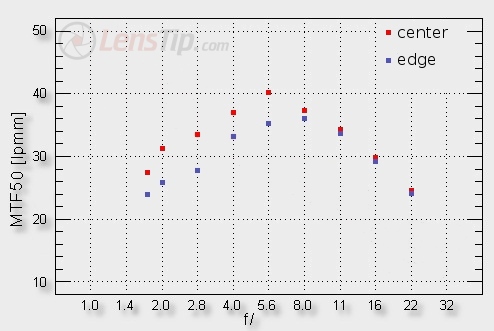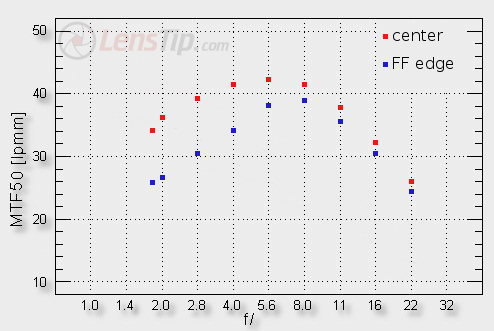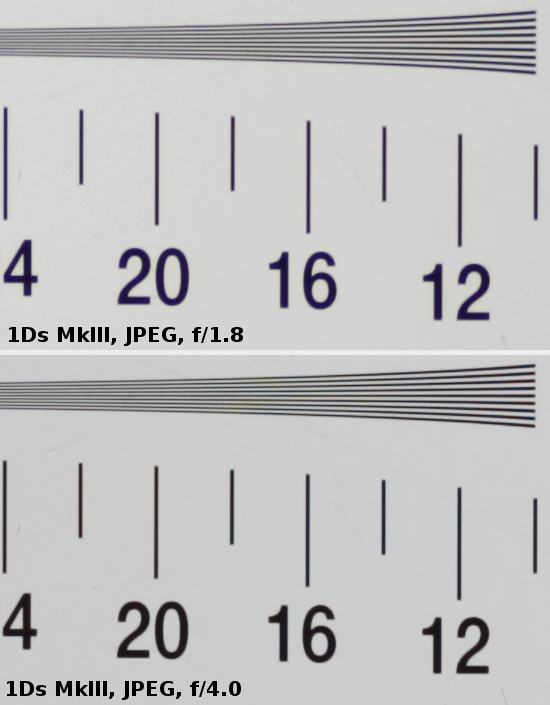Canon EF 85 mm f/1.8 USM
4. Image resolution

As you see at the maximum relative aperture the image just brushes against full usefulness level. It’s enough you stop down the lens slightly and the image quality becomes flawless because by f/2.0 the MTF values got to almost 32 lpmm. On further stopping down the image quality improves, reaching its peak by f/5.6. The level of 40 lpmm can be hardly called record-breaking but it certainly allows to shot very sharp photos.
Please Support UsIf you enjoy our reviews and articles, and you want us to continue our work please, support our website by donating through PayPal. The funds are going to be used for paying our editorial team, renting servers, and equipping our testing studio; only that way we will be able to continue providing you interesting content for free. |
- - - - - - - - - - - - - - - - - - - - - - - - - - - - - - - - - - - - - - - - - - - - - - - -
The difference between the image quality in the centre of the frame and on the edge of the APS-C sensor is not huge. If you want to enjoy fully acceptable sharpness you must remember about stopping down the lens to a bit above f/2.8.
The next test of the Canon 1.8/85 we conducted 4 years later and this time we used the full frame EOS 1Ds MkIII camera. It features exactly the same linear pixel density like the 20D. Its sensor is much newer, though, and with better software, so the results are by 1-2 lpmm higher than those achieved on the EOS 20D. You should remember this if you want to compare directly the results of different lenses.
The graph below shows the result the tested lens got in the frame centre and on the edge of full frame.

Even if you lowered the results, presented above, by 1-2 lpmm to compare them directly with those reached on the 20D, it is clear that the second specimen of the EF 85 mm f/1.8 lens that found its way to our editorial office is better. It is especially visible at the maximum relative aperture. When it comes to the MTF50 results the lens gets to the level of over 34 lpmm so it is able to provide fully useful images there. The highest image resolution we achieve by f/4.0-f/8.0 where the lens gets to 42 lpmm. “Prime” lenses, designed and produced nowadays, can reach the results of 46 lpmm on 1Ds MkIII (e.g. the expensive Canon 85L f/1.2 got 45.5 lpmm by f/4.0) so the Canon 1.8/85, tested here, lags a bit behind. The difference is so slight, though, that in the case of amateur uses it shouldn’t bother us at all.
The interesting thing is that when you buy this model you should check how a particular specimen of this lens fares by f/1.8. There are specimens which are just moderately useful there and also those which provide quite satisfactory images.
When it comes to the performance on the edge of full frame, the Canon EF 85 mm f/1.8 fares quite decently. It is full useful already from f/2.8 and on further stopping down it can provide really sharp images. The Canon performs significantly better here than the cheaper Samyang 1.4/85, faring a lot like the more expensive Sigma 1.4/85.
At the end of the chapter we present our test chart crops taken during the second testing session.
 |






